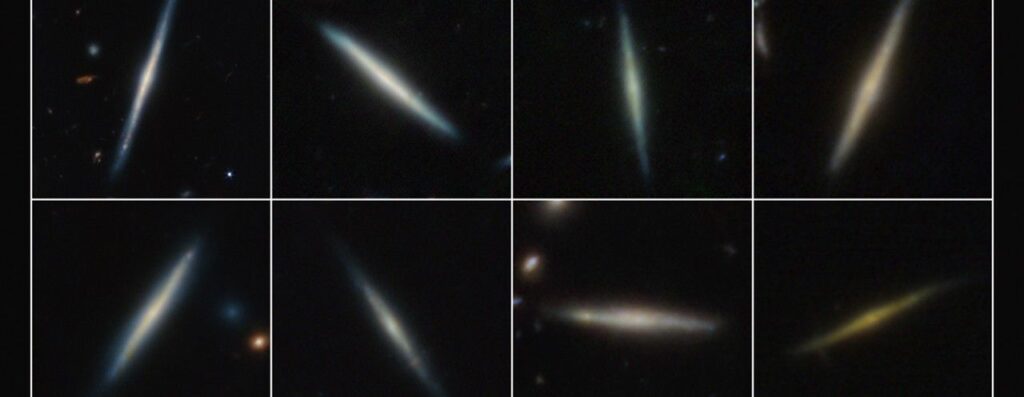
Present-day disk galaxies, including our own Milky Way, often feature a complex dual structure: a thick, star-filled outer disk and a thinner, embedded disk of stars. The Milky Way’s thick disk measures approximately 3,000 light-years in height, while its thin disk is around 1,000 light-years thick. The formation of this dual disk structure has long puzzled astronomers, but recent findings from NASA’s James Webb Space Telescope are shedding light on the mystery.
By analyzing archival data from multiple observational programs, a team of astronomers has made significant progress in understanding the origins of disk galaxies. The researchers meticulously identified and analyzed a sample of 111 edge-on disk galaxies spanning up to 11 billion years ago, or roughly 2.8 billion years after the Big Bang. This marks the first time scientists have investigated thick- and thin-disk structures across such vast distances, bridging the gap between early universe observations and the study of our galaxy’s history.
Unveiling the Dual Disk Structure
Takafumi Tsukui, lead author of the study and a researcher at the Australian National University, emphasized the groundbreaking nature of these measurements.
“This unique measurement of the thickness of the disks at high redshift, or at times in the early universe, is a benchmark for theoretical study that was only possible with Webb,”
Tsukui stated. The James Webb Space Telescope’s resolution and ability to penetrate dust allowed astronomers to distinguish between the faint, old stars of the thick disk and the brighter, younger stars of the thin disk.
The team’s analysis suggests that thick disk formation precedes thin disk formation, with the timing dependent on the galaxy’s mass. High-mass galaxies transitioned to a two-disk structure around 8 billion years ago, while low-mass galaxies developed their thin disks approximately 4 billion years ago. Emily Wisnioski, a co-author of the paper, noted,
“To see thin stellar disks already in place 8 billion years ago, or even earlier, was surprising.”
A Turbulent Formation Process
To further understand the transition from a single thick disk to a dual-disk structure, the team examined additional data on galactic gas motion from the Atacama Large Millimeter/submillimeter Array (ALMA) and ground-based surveys. Their findings support the “turbulent gas disk” scenario, one of the leading hypotheses for thick- and thin-disk formation. In this model, a turbulent gas disk in the early universe triggers intense star formation, resulting in a thick stellar disk. Over time, as stars form, the gas disk stabilizes and thins.
Massive galaxies, which can convert gas into stars more efficiently, settle sooner than their low-mass counterparts, leading to earlier thin disk formation. The researchers emphasize that the formation of thick and thin disks is not isolated; the thick disk continues to grow, albeit more slowly than the thin disk.
Implications for the Milky Way
The insights gained from this study have significant implications for understanding our own galaxy. The transition period from a thick disk to a dual-disk structure coincides with the formation of the Milky Way’s thin disk. With the Webb Telescope, astronomers can further investigate Milky Way-like progenitors—galaxies that preceded the Milky Way—offering potential clues about our galaxy’s formation history.
Looking ahead, the research team plans to enhance their analysis by incorporating additional data points into their sample of edge-on galaxies. Tsukui expressed a desire to explore further, stating,
“While this study structurally distinguishes thin and thick disks, there is still much more we would like to explore. We want to add the type of information people usually get for nearby galaxies, like stellar motion, age, and metallicity.”
This approach aims to refine the understanding of disk formation by bridging insights from galaxies both near and far.
The results of this study were published in the Monthly Notices of the Royal Astronomical Society. The James Webb Space Telescope, a collaborative effort led by NASA with partners ESA and CSA, continues to revolutionize our understanding of the universe, from solving mysteries in our solar system to probing the origins of galaxies.







